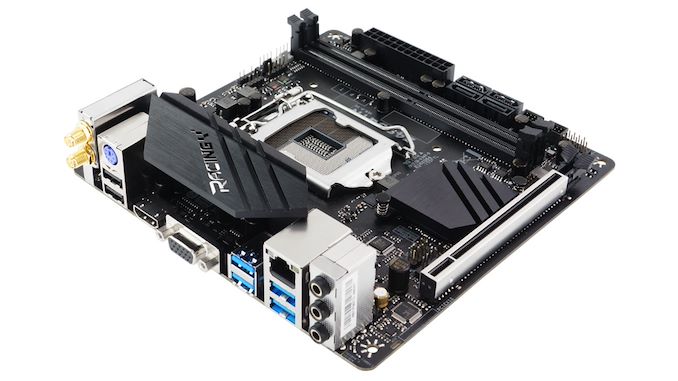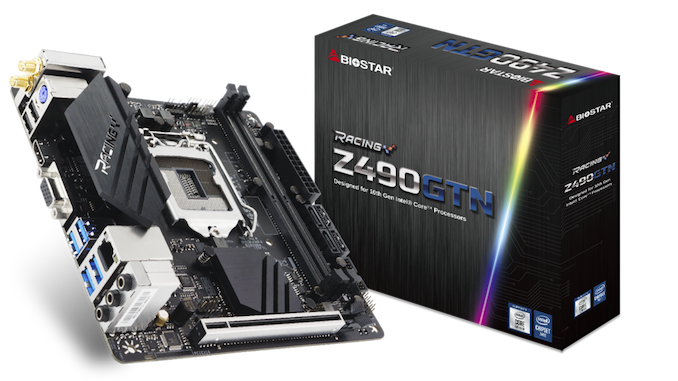The Biostar Racing Z490GTN Review: $200 for Comet Lake mini-ITX
by Dr. Ian Cutress & Gavin Bonshor on June 5, 2020 10:00 AM EST- Posted in
- Motherboards
- Intel
- Biostar
- Z490
- 10th Gen Core
- Comet Lake
- Z490GTN

Small form factor boards are always a key talking point for any desktop market. The usual breakdown on Mini-ITX sales for any given generation is usually around 10%, and because these boards end up in the lower-cost systems, there tends to be a focus on the cheaper end of the spectrum, even when it comes to the Z series chipset which is the one with all the bells and whistles. With Intel's new Comet Lake-S processors, ranging from Celeron all the way up to Core i9, and with the new socket for Comet Lake, there will be a renewed demand for those looking to build a small form factor Intel system. One of the popular mini-ITX low-cost boards in each generation is from BIOSTAR, and today we're testing the Z490GTN.
Building the Biostar Battleship
All the arguments for building a small form factor system have been discussed ad nauseum: the home theatre mini PC (HTPC), the small form factor gaming machine, the single-use server option, or the low power desktop or work machine. Throughout the decade, motherboard companies have varied between low cost mini-ITX designs, saving a lot of pennies in design, all the way to the high performance, high cost, flashy models that cost more than a lot of decent ATX full-sized motherboards. We can see these motherboards, on Z-series chipsets, range from $120 to $350+, and it is an interesting exercise to see what price segments end up being promoted in which generation.
With the new Z490 chipset, Biostar has gone for a more mid-range design in the Z490GTN. This $200 model is in the price bracket often seen as hyper-competitive. At that price, it's perhaps too-high for a basic system (wait for the B-series chipset version), which means that Biostar has to make an effort to provide enough mid-range features to make the motherboard worthwhile. With the Z490GTN, the key highlights include a PCIe 3.0 x4 NVMe slot, helpful connector and header placement (often an issue on these sized boards), a reinforced PCIe 3.0 x16 slot, and support for 64 GB of DDR4-4000.
The GTN range of Biostar mini-ITX boards have been popular over the years, often due to their simplicity and the price. There's nothing substantially excellent about these boards - they seem to be able to function and provide a no-nonsense implementation. The Z490GTN is one such example, implementing a simple 6+2 phase design on the power delivery, SATA ports that don't block each other when using angled connectors, support for legacy connectivity, an Intel gigabit ethernet controller, and budget Realtek audio. One thing I should point out that while Biostar states that this motherboard has the ability to support Wi-Fi 6, it is only though an add-in card, which is not bundled with the motherboard.
Biostar is keen to promote its use of higher density pin connectors in the 24-pin ATX and 8-pin 12V connections, which the company says reduces in-wire resistance and therefore offers a lower wire temperature, leading to fewer issues with pin degredation. It seems that perhaps Biostar's motherboards are used in locations where this is an issue, such as high-humidity countries or in countries where the room temperature is 30ºC+ (often these locations go together, too).
Results Summary
On the whole, we saw no major surprises from the Biostar Z490GTN, and it retained a good deal of competitiveness against our other Z490 platforms. Out of the boards tested so far, the Z490GTN scored its main win in idle power, which is often a key element for these small form factor motherboards. Everything else was within margin with other motherboards.

Overclocking and thermals with a mini-ITX board is often a key battleground, as it balances good design with good firmware as well as how much is spent on the power delivery and cooling.
As part of this test, we tested with two BIOSes (514 and 522), and the 522 results were higher but it came at the expense of worse thermals. They both gave high VRM temperatures, above 85ºC+. This is one area where a $200 mini-ITX board doesn't seem to cut it - we saw a +36ºC delta compared to the bigger, more expensive ATX boards, using our 8-core Comet Lake CPU set to 5.1 GHz all-core. At these temperatures we were even riding the rails of stability in our overclock. Even though this motherboard is a Z490, and one of the benefits therein is going to be the ability to overclock, perhaps this isn't the best board to do it.
Overall this board has potential, and it's worth digging into the details to find out if this is the right motherboard for you.
Motherboard Tested by Gavin Bonshor.
Overview, Visual Inspection, and Conclusion by Ian Cutress.
Other pages written by Gavin Bonshor.













40 Comments
View All Comments
DanNeely - Friday, June 5, 2020 - link
The only chipset on the market that needs active cooling is the AMD 570, because PCIe 4.0 is a power hog.PeachNCream - Sunday, June 7, 2020 - link
Absolutely it will be fine. The vast majority of reasonably designed motherboards need no active cooling anywhere. The few that add them do so because of PCIe 4.0 (currently only an AMD side thing) or fans are slapped onto VRMs to hide poor design decision under the guise of "overclocker friendly voltage regulator cooling enhancements" so people throw more money at supposedly higher margin parts while feeling like they are somehow obtaining greater value that justifies the expenditure. Classic marketing is still alive and well because, despite generations of exposure to it, we haven't gotten much smarter about identifying and coping with it.eastcoast_pete - Friday, June 5, 2020 - link
Thanks Gavin and Ian! Fully agree - way overpriced for what it has and can do.One suggestion, especially for boards that are likely to be used in an HTPC: please include the exact HDMI version supported (with specs) as well as any information on display port and Thunderbolt
capabilities, including, of course, complete absence of such features. Thanks!
As for the current state of affairs with Intel in the HTPC space: they are lucky that AMD has not made Renoir chips available for socketed mini-desktops, or they could kiss that market goodbye.
Slash3 - Friday, June 5, 2020 - link
Socketed Renoir is on the way.lmcd - Friday, June 5, 2020 - link
AM4 seems pretty big for ITX based on the ASRock board I have. This board might be bad but Intel should still have an upper hand, unless Comet Lake is bigger than past socket + chipset pairings?Deicidium369 - Friday, June 5, 2020 - link
has the same HSF hole spacing - so about the same size - it's only 49 additional pinslmcd - Saturday, June 6, 2020 - link
I meant the chipset.eastcoast_pete - Friday, June 5, 2020 - link
Unless I overlooked it, a review of AM4 mini ITX Boards would be interesting, if just for comparison. There are even a couple of x570 boards with PCIe 4.0 for about the price of this board here available, and they include Thunderbolt and WiFi connectivity, and a much better audio. However, my own preference would be for a cheaper B450 or 550 board for about half the price; that's enough for an HTPC setup.Spunjji - Monday, June 8, 2020 - link
How would a smaller socket+chipset give them the upper hand for HTPCs when Renoir offers better CPU performance for a given TDP and markedly superior graphics?AM4 might be "big for ITX", but that's irrelevant if you can still build an ITX system around it.
Operandi - Friday, June 5, 2020 - link
Looks like a pretty weak / inefficient VRM.Speaking of which if you are going to cover the VRM section of a board you need to go into more detail than simply stating the VRM configuration. 6+2 is almost meaningless when the quality of MOSFETS and drivers is what really determines how much power a board is capable of delivering and how efficient it will be. With the specs of the components involved and the layout along with some simple math is pretty easy to ballpark what a board is capable of.